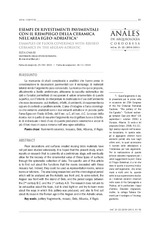Mostrar el registro sencillo del ítem
Esempi di rivestimenti pavimentali con il reimpiego della ceramica nell'area Egeo-Adriatica
| dc.contributor.author | Omari, Elda | |
| dc.date.accessioned | 2018-01-22T11:12:47Z | |
| dc.date.available | 2018-01-22T11:12:47Z | |
| dc.date.issued | 2011 | |
| dc.identifier.issn | 1130-9741 | |
| dc.identifier.uri | http://hdl.handle.net/10396/15915 | |
| dc.description.abstract | La mancanza di studi complessivi e analitici che hanno preso in considerazione le decorazioni pavimentali con il reimpiego di materiali laterizi rende l’argomento poco conosciuto. La ricerca che qui si propone, attualmente a livello preliminare, attraverso la raccolta sistematica dei dati e l’analisi permetterà di recuperare il valore ornamentale di queste superfici, con l’intento di interpretare le destinazioni d’uso dell’ambiente che esse decoravano: può trattarsi, infatti, di ambienti, di rappresentanza oppure di contesti a carattere servile. L’area d’indagine e l’arco cronologico che verranno analizzati sono i due versanti adriatici e in piccola parte l’area Egea con l’isola di Delo, dal II sec. a.C. al I sec. d.C. Lo scopo della ricerca non è quello di esaurire l’argomento ma di gettare luce e di tentare di individuare i modi d’uso di queste produzioni ceramiche e ancor di più il loro riuso in epoca romana nell’area egeo-adriatica. | es_ES |
| dc.description.abstract | Floor decorations and surfaces created reusing brick materials have not yet been studied extensively. It is hoped that the present study, which reports on research that is currently at a preliminary stage, will eventually allow for the recovey of the ornamental value of these types of surfaces through the systematic collection of data. The specific aim of this article is to find out about the functions that the rooms decorated with these mosaics had. Indeed, they could be used as representation rooms, service rooms or kitchens. The area being researched and the chronological period which will be analysed are the Adriatic sea front and, to some extent, the Aegean sea front with the island of Delo, and the period ranges between the 2nd century B.C. and the 1st century A.D. The research does not aim to be exhaustive about the topic, but to shed light on and try to learn more about the ways in which this pottery was produced, and also to find out about its reuse in the Roman age in the Aegean and in the Adriatic areas. | es_ES |
| dc.format.mimetype | application/pdf | es_ES |
| dc.language.iso | ita | es_ES |
| dc.publisher | Universidad de Córdoba, Área de Arqueología | es_ES |
| dc.rights | https://creativecommons.org/licenses/by/3.0/ | es_ES |
| dc.source | Anales de Arqueología cordobesa 21-22, 81-92 (2010-2011) | es_ES |
| dc.subject | Frammenti ceramici | es_ES |
| dc.subject | Mosaico | es_ES |
| dc.subject | Delo | es_ES |
| dc.subject | Albania | es_ES |
| dc.subject | X Regio | es_ES |
| dc.subject | Pottery fragments | es_ES |
| dc.subject | Mosaic | es_ES |
| dc.title | Esempi di rivestimenti pavimentali con il reimpiego della ceramica nell'area Egeo-Adriatica | es_ES |
| dc.title.alternative | Examples of floor coverings with reused ceramics in the Aegean-Adriatic | es_ES |
| dc.type | info:eu-repo/semantics/article | es_ES |
| dc.relation.publisherversion | https://www.uco.es/ucopress/ojs/index.php/anarcor/index | es_ES |
| dc.rights.accessRights | info:eu-repo/semantics/openAccess | es_ES |

